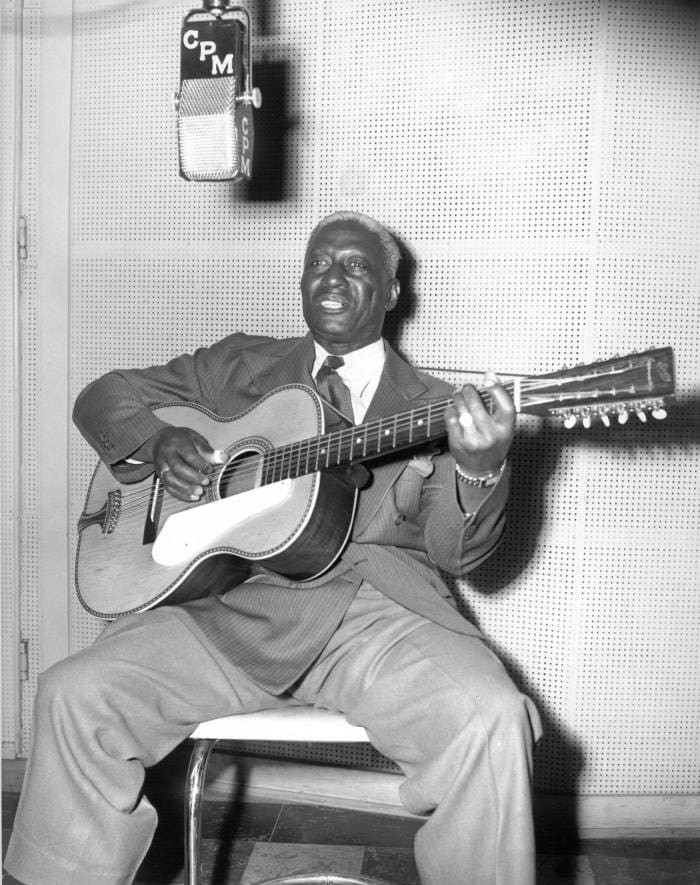Nirvana’s 1993 MTV Unplugged performance is etched in music history, particularly its closing track: “Where Did You Sleep Last Night.” Kurt Cobain’s raw, emotional delivery of the song, culminating in a visceral scream at the final word, resonated deeply with audiences. This poignant rendition, captured just months before Cobain’s tragic death, became an enduring testament to his artistry and the band’s ability to tap into profound human emotions. The lyrics themselves are stark – depicting a grim scene with the lines “his head was found in a driving wheel / but his body was never found” – and Cobain’s interpretation amplified their haunting power.
 Lead Belly performing courtesy of the John Reynolds Collection
Lead Belly performing courtesy of the John Reynolds Collection
Many recognized the song as a cover, specifically of Lead Belly, the legendary folk and blues musician. Lead Belly, born Huddie Ledbetter in the late 19th century, popularized versions of the song under titles like “Where Did You Sleep Last Night” and “Black Girl (In the Pines).” His life story was as compelling as his music. Growing up in Louisiana and traversing the American South, he absorbed a vast repertoire of songs through oral tradition. His life took dramatic turns, including two prison sentences for murder and attempted murder. It was during a prison stint that he was “discovered” by folklorists, leading to recordings and a performance career in New York City, bringing his powerful voice and interpretations of American folk music to a wider audience.
However, tracing the lineage of “Where Did You Sleep Last Night” reveals a history far older and more complex than Lead Belly’s recordings alone. Dolly Parton, a giant in country music, has stated, “the song has been handed down through many generations of my family. I don’t ever remember not hearing it and not singing it. Any time there were more than three or four songs to be sung, ‘In the Pines’ was one of them.” This suggests the song’s roots lie deep within Appalachian folk tradition, likely originating within Black communities in the southern Appalachian mountains during the late 1800s. Some early versions even allude to “Joe Brown’s coal mine,” referencing a Georgia governor from that era, further grounding the song in a specific time and place within American history.
The song’s enduring nature is evidenced by the sheer number of variations documented over time. In 1970, researcher Judith Mculloh meticulously cataloged 160 distinct versions, and countless more interpretations have emerged since. Each rendition offers unique lyrical and thematic nuances, yet certain motifs consistently reappear across versions, creating a shared, evolving narrative.
One of the most prevalent recurring elements is the imagery of a train or railroad. Often described in hyperbolic terms – “100 cars long” or taking “three hours to pass through town” – the railroad acts as a potent symbol, often foreshadowing misfortune. In some versions, it represents loss and separation, carrying a lover away. In others, it becomes an instrument of tragedy, causing death beneath its wheels. This recurring motif underscores the song’s themes of transience, fate, and the often-harsh realities of life.
Central to nearly every version of the song is the figure of a girl who has spent the night “in the pines.” Her relationship to the singer varies – sometimes she’s a lover, other times a daughter – adding layers of ambiguity and emotional depth. Unraveling the significance of this girl and her refuge in the pines is crucial to understanding the song’s core emotional landscape. The pines become a space of isolation and introspection. Has she sought refuge there due to wrongdoing? Perhaps she’s guilty of infidelity or a more serious transgression, hiding in fear of consequences. Or is she a figure of hardship, driven to the pines by circumstance, with nowhere else to turn? Whether guilty or downtrodden, the girl in the pines embodies the song’s haunting and heavy emotional weight. “In the pines, in the pines, where the sun never shines” – this repeated line encapsulates a state of despair, isolation, and perhaps, a confrontation with one’s own inner turmoil, making “Where Did You Sleep Last Night” a timeless exploration of human vulnerability and the shadows that dwell within us.
Works Cited
360, Studio. “The Haunting Power of ‘in the Pines.’” Slate Magazine, 19 Apr. 2019, slate.com/culture/2019/04/in-the-pines-song-kurt-cobain.html.
“American Routes – In the Pines.” American Routes, scholarblogs.emory.edu/americanroutes/lyrics/pines/. Accessed 2 June 2023.
“The Haunting Power of ‘in the Pines.’” The World from PRX, 18 Apr. 2019, theworld.org/stories/2019-04-18/haunting-power-pines.
“Lead Belly.” Encyclopædia Britannica, 6 May 2023, www.britannica.com/biography/Leadbelly.
Weisbard, Eric. “A Simple Song That Lives beyond Time.” The New York Times, 13 Nov. 1994, www.nytimes.com/1994/11/13/arts/pop-music-a-simple-song-that-lives-beyond-time.html?pagewanted=1.
